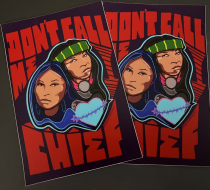“Don’t Call Me Chief”: Native Artists Protest Racist NFL Mascots Favorite
PHOENIX — As Super Bowl LVII was getting underway in Glendale, Arizona, on February 12, artist and Apache Skateboards founder Douglas Miles (San Carlos Apache, Akimel O’odham) was protesting racist mascots in the NFL by painting a mural-style portrait of Geronimo with the words “Don’t Call Me Chief” for a community event at Grassrootz, a Black- and worker-owned bookstore near downtown Phoenix. Meanwhile, protesters who’d gathered near State Farm Stadium marched while chanting “Change the name” and “Stop the chop,” both references to the Kansas City Chiefs, who would eventually go on to win the game as fans in the stadium used the chopping arm gesture that these activists find offensive.
“The Kansas City team needs to let go of all Native appropriation,” Amanda Blackhorse (Diné), founder of Arizona to Rally Against Native American Mascots, told Hyperallergic just days before the big game. “That includes their team name, logo, stadium name, the big drum, and the tomahawk chop,” she explained.
It’s a sentiment shared by Rhonda LeValdo, founder of the national Not In Our Honor coalition on racism in sports and media, who traveled from Kansas City for Sunday’s march. “On their helmets, it says ‘End Racism,’ but why have that if they’re actively mocking Native people?” she asked.
Several artists supported the protest, although city attempts to create a Super Bowl “clean zone” around downtown Phoenix meant Miles and other artists looking for mural space on public or private property had to find other ways to share their work. Klee Benally (Diné) of Flagstaff, Arizona posted anti-mascot statements and images on social media. Ben West (Cherokee) of Los Angeles spoke during a Scottsdale, Arizona, screening for Imagining the Indian: The Fight Against Native American Mascoting, a 2022 film he co-directed. And Douglas Miles, whose ongoing art practice embodies a critique of colonizing culture, gave out large “Don’t Call Me Chief” stickers conceived as a form of guerilla protest.
Protesters gather in Glendale, Arizona, to oppose Super Bowl’s racist mascots (photo Amanda Blackhorse)
Douglas Miles putting finishing touches on his Super Bowl protest mural, Phoenix
Even so, the most visible public-facing art wasn’t created as a protest. Instead, it was used to promote this year’s championship game. The NFL commissioned Phoenix-based Lucinda “La Morena” Hinojos (Apache, Yaqui, Akimel O’odham, Chicana) to create artwork that appeared on tickets and the souvenir program for Super Bowl LVII. She also painted a massive mural in downtown Phoenix, with the help of several Indigenous artists.
“There are artists with contracts and artists without contracts,” fashion designer Cher Thomas (Akimel O’odham, Cocopah, Yavapia, Piipaash, Dinê) of Laveen, Arizona, told Hyperallergic the week before the game. “Only one is free to speak for themselves,” she said.
Hinojos could not be reached for comment, and the NFL has not responded to a request for comment on allegations by activists that the league is trying to “divide and conquer” Indigenous people.
Blackhorse said she recognizes that some Native artists may be creating work for the NFL out of financial necessity, or as a way to increase Native representation. “You cannot get me to fight my own community,” Blackhorse said. “But this is a conversation we need to have.”












